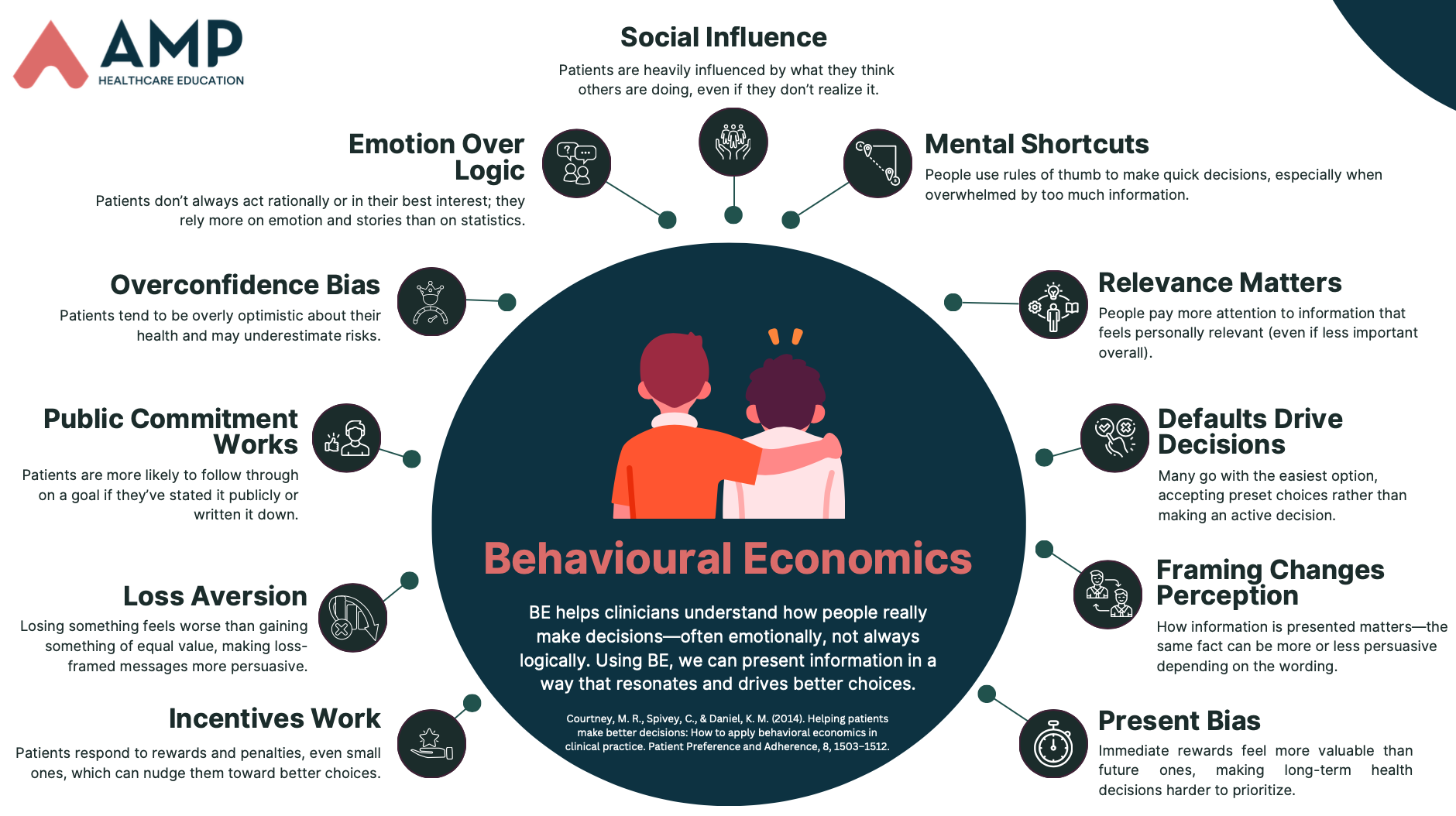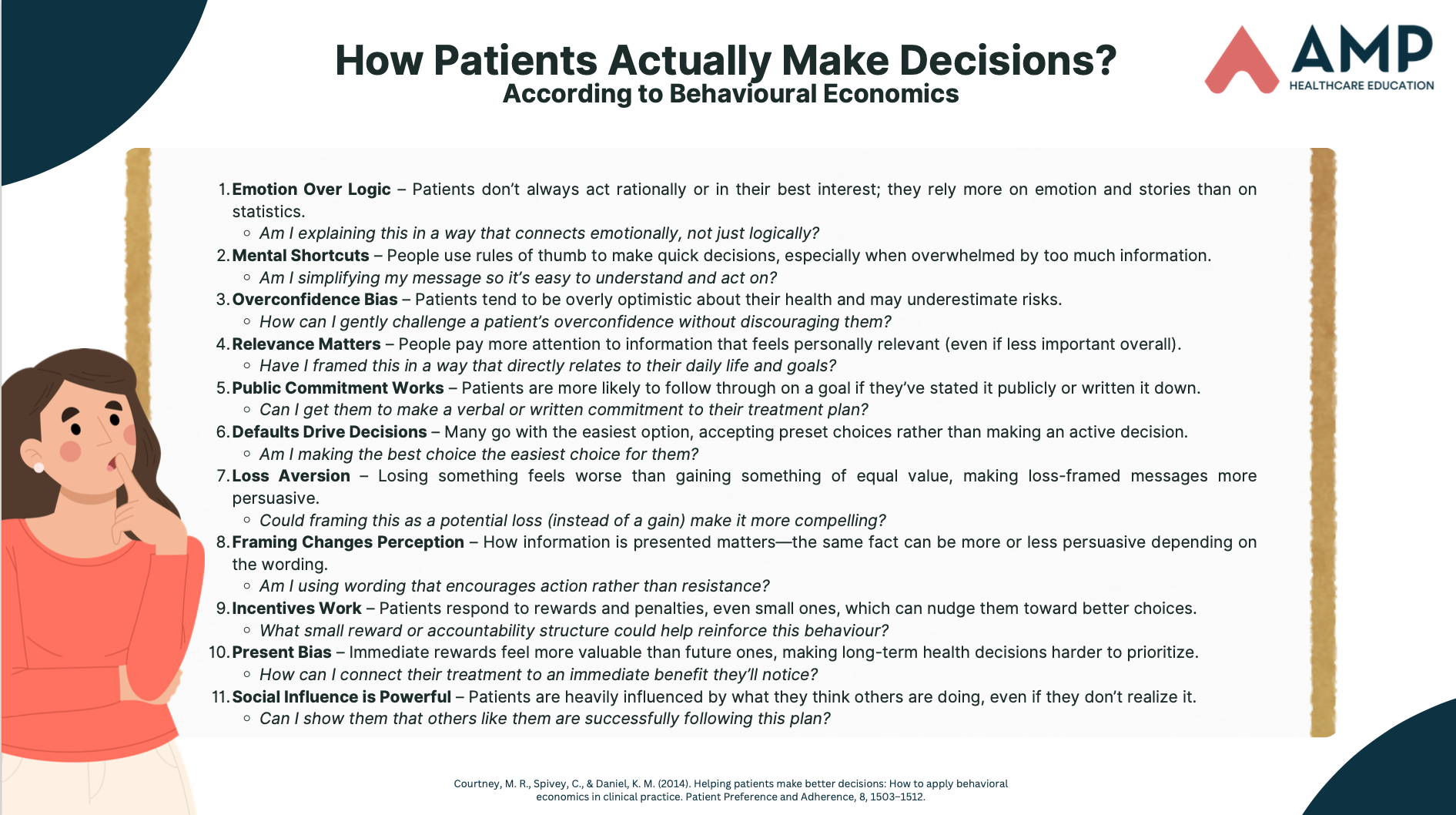Sean Overin
Hidden Forces That Shapes Decisions

Helping Patients Make Better Decisions: What Clinicians Need to Know About Behavioural Economics?
Ever wonder why some patients follow their treatment plans religiously while others ghost their exercises after the first week?
You’ve explained the benefits. You’ve laid out a great plan. And yet… they don’t follow through.
It’s frustrating, right?
I’ve been down this road before, and it’s why I’ve become curious about what actually gets patients to engage in their care. I wanted to find ways to bridge the gap between what we know works and what patients actually do. That’s when I came across behavioural economics (BE).
BE tells us that people rely on emotion, mental shortcuts, and social influence when making choices. As physios, if we ignore this, we’re fighting human nature instead of working with it.
By understanding how patients actually make decisions, we can structure our advice in ways that increase adherence and subsequently improve outcomes—without adding extra work to our already busy schedules.
Importantly, I think BE helps explain why people make irrational, emotional, or impulsive choices—even when it’s in their best interest to do otherwise. When we understand the hidden forces behind patient decision-making, we can present treatment in a way that resonates and drives better follow-through.
Importantly, I think BE helps explain why people make irrational, emotional, or impulsive choices—even when it’s in their best interest to do otherwise. When we understand the hidden forces behind patient decision-making, we can present treatment in a way that resonates and drives better follow-through.

How Behavioural Economics Can Make You a Better Clinician?
A fascinating paper by Courtney, Spivey, & Daniel (2014) explores how BE can help patients make better health decisions. The key lesson?
👉 It’s not just what we tell patients—it’s how we tell them.
Let’s break down how this plays out in clinical practice:


Let’s say you’re treating a patient with chronic knee pain.
They’re skeptical about your strengthening program because they’ve “tried exercises before and they didn’t work.” There are a few ways to go about this conversation, but considering the paper we are chatting about today, lets see how it could apply.
Here’s how you could apply BE principles to increase potential buy-in:
1️⃣ Framing – Instead of saying: “Strengthening your knee will help reduce pain over time.”
2️⃣ Relevance – Instead of saying: “Strong quads help keep the knee joint happy.”
3️⃣ Social Proof – Instead of saying: “This is the best approach based on research.”
Here’s how you could apply BE principles to increase potential buy-in:
1️⃣ Framing – Instead of saying: “Strengthening your knee will help reduce pain over time.”
- Try: “Most people with knee pain feel better within six weeks when they consistently do these two simple exercises. How can we make this easy for you to get done?”
- Why? This makes success feel real, time-bound, achievable and gets the patient involved in the decision making.
2️⃣ Relevance – Instead of saying: “Strong quads help keep the knee joint happy.”
- Try: “If your goal is to keep hiking without pain, these exercises strengthen the muscles that act as shock-absorbers on your favourite trails.”
- Why? Now, the patient sees how it directly benefits their life through the use of metaphor.
3️⃣ Social Proof – Instead of saying: “This is the best approach based on research.”
- Try: “Patient's who do these exercises with the same issue as you, get back to running the way they want to."
- Why? People are more likely to trust a plan when they know others have succeeded with it.

It's not just what it's how we deliver information that matters...
🚀 The best treatment plan is useless if the patient never follows it.
By applying behavioural economics, we can:
✅ Increase adherence without extra effort
✅ Communicate more effectively so patients actually absorb what we say
✅ Make the best option the easiest option
Want a quick cheat sheet?
📊 Infographic: “The 11 Hidden Forces That Shape Patient Decisions” This one-page guide breaks down the key behavioural economics principles and how to use them in physio practice.
👉 [Download the Infographic Here]
By applying behavioural economics, we can:
✅ Increase adherence without extra effort
✅ Communicate more effectively so patients actually absorb what we say
✅ Make the best option the easiest option
Want a quick cheat sheet?
📊 Infographic: “The 11 Hidden Forces That Shape Patient Decisions” This one-page guide breaks down the key behavioural economics principles and how to use them in physio practice.
👉 [Download the Infographic Here]

Final Thoughts...
Rehab is not just about education, exercises and manual therapy—it’s about behaviour change. The better we understand how patients actually make decisions, the better we can help them get results.
What do you think? Have you noticed any of these decision-making biases in your patients?
What do you think? Have you noticed any of these decision-making biases in your patients?
If you want to learn more about patient-centred care check out our course!
Sean Overin, MPT, tDPT Registered Physiotherapist
Subscribe to our newsletter
Every Friday we cover must read studies, how they fit in practice, give it real world context, provide top resources and one sticky idea.
Thank you!
You have successfully joined our Friday 5 Newsletter subscriber list.
